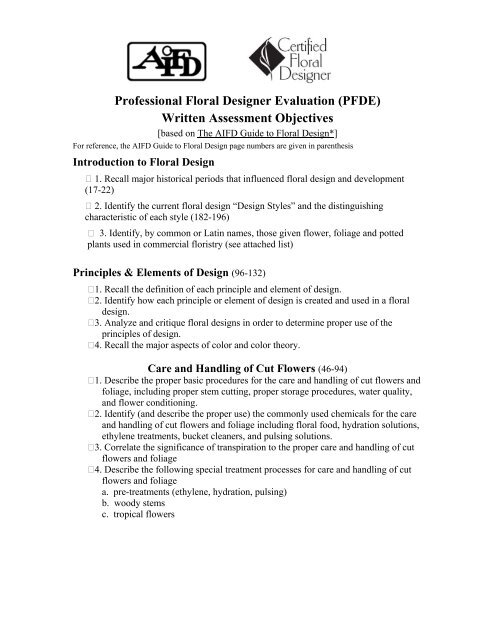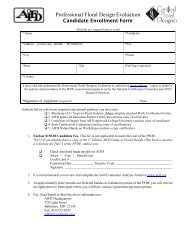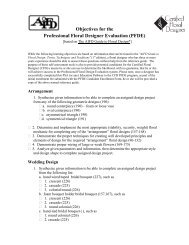PFDE Online Written Test Objectives - AIFD
PFDE Online Written Test Objectives - AIFD
PFDE Online Written Test Objectives - AIFD
You also want an ePaper? Increase the reach of your titles
YUMPU automatically turns print PDFs into web optimized ePapers that Google loves.
Professional Floral Designer Evaluation (<strong>PFDE</strong>)<br />
<strong>Written</strong> Assessment <strong>Objectives</strong><br />
[based on The <strong>AIFD</strong> Guide to Floral Design*]<br />
For reference, the <strong>AIFD</strong> Guide to Floral Design page numbers are given in parenthesis<br />
Introduction to Floral Design<br />
1. Recall major historical periods that influenced floral design and development<br />
(17-22)<br />
2. Identify the current floral design “Design Styles” and the distinguishing<br />
characteristic of each style (182-196)<br />
3. Identify, by common or Latin names, those given flower, foliage and potted<br />
plants used in commercial floristry (see attached list)<br />
Principles & Elements of Design (96-132)<br />
1. Recall the definition of each principle and element of design.<br />
2. Identify how each principle or element of design is created and used in a floral<br />
design.<br />
3. Analyze and critique floral designs in order to determine proper use of the<br />
principles of design.<br />
4. Recall the major aspects of color and color theory.<br />
Care and Handling of Cut Flowers (46-94)<br />
1. Describe the proper basic procedures for the care and handling of cut flowers and<br />
foliage, including proper stem cutting, proper storage procedures, water quality,<br />
and flower conditioning.<br />
2. Identify (and describe the proper use) the commonly used chemicals for the care<br />
and handling of cut flowers and foliage including floral food, hydration solutions,<br />
ethylene treatments, bucket cleaners, and pulsing solutions.<br />
3. Correlate the significance of transpiration to the proper care and handling of cut<br />
flowers and foliage<br />
4. Describe the following special treatment processes for care and handling of cut<br />
flowers and foliage<br />
a. pre-treatments (ethylene, hydration, pulsing)<br />
b. woody stems<br />
c. tropical flowers
Design Techniques and Applications<br />
1. Define and identify any of the following design techniques (151-156)<br />
Air taping Armature use Baling<br />
Banding Basing Binding<br />
Clustering Collaring Facing<br />
Framing Grouping Hand-tying<br />
Kubari Layering Pavé<br />
Picking Pillowing Reflexing<br />
Shadowing Sheltering Spiraling<br />
Spray gluing Stacking Terracing<br />
Weaving<br />
Zoning<br />
2. Identify the different gauges of florist wire (175)<br />
3. Identify the different widths of florist ribbon (334)<br />
4. Identify any of the following mechanics techniques/mechanics aids and their<br />
practical application to professional floral design (157-168)<br />
Anchor pin Anchor tape Bind wire<br />
Bouquet holder Candle pick Casket saddle<br />
Corsage tape Easel Floral adhesive<br />
Floral clay Hyacinth stake Iglu<br />
Paddle wire Pew clip Polyfoil<br />
Water pick Water tube Waxed string<br />
Wired wood pick<br />
5. Identify the types of “Attaching Mechanics” and their application to professional<br />
floral design (166)<br />
6. Identify the types of “Binding Mechanics” and their application to professional<br />
floral design (166)<br />
7. Identify the types of “Funeral Mechanics” and their application to professional<br />
floral design (168)<br />
8. Identify the types of “Foam Mechanics” and their application to professional<br />
floral design (167)<br />
Personal Flowers: To Wear and Carry<br />
1. Determine proper wiring techniques for given flowers – such as clutch wiring,<br />
cross-pierce wiring, hairpin wiring, and insertion wiring (169-175)<br />
2. Identify the different types of “flowers to wear” (222-224)<br />
3. Identify the different types of “flowers to carry” (225-229)
Arrangements: Everyday and Sympathy<br />
1. Determine the most appropriate (stability, security, weight) floral mechanic for<br />
completing any of the “arrangement” floral designs (157-168)<br />
2. Determine the most appropriate technique of wiring of large or weak flowers<br />
(169-175)<br />
3. Determine the most appropriate (stability, security, weight) floral mechanic for<br />
completing a sympathy tribute floral design (200-212)<br />
Shop Management<br />
1. Complete a retail pricing calculation based on mark-up (325) of the cost of goods<br />
sold (321)<br />
2. Compute the addition of a labor charge to a retail pricing calculation (324)<br />
• The <strong>AIFD</strong> Guide to Floral Design is available from www.<strong>AIFD</strong>.com
Flower ID List<br />
Foliage ID List<br />
Common Name<br />
Genus Name<br />
Common Name<br />
Genus Name<br />
1. Alstroemeria Alstroemeria<br />
2. Anemone Anemone<br />
3. Bells of Ireland Moluccella<br />
4. Bird of Paradise Strelitzia<br />
5. Bullet Allium Allium<br />
6. Calla Zantedeschia<br />
7. Carnation Dianthus<br />
8. Chrysanthemum – Football Chrysanthemum<br />
9. Chrysanthemum – Fuji Chrysanthemum<br />
10. Chrysanthemum – Spray Chrysanthemum<br />
Button<br />
11. Chrysanthemum – Spray Chrysanthemum<br />
Cushion<br />
12. Chrysanthemum – Spray Chrysanthemum<br />
Daisy<br />
13. Daffodil Narcissus<br />
14. Delphinium Delphinium<br />
15. Freesia Freesia<br />
16. Gerbera Gerbera<br />
17. Gladiola Gladiolus<br />
18. Heather Erica<br />
19. Hydrangea Hydrangea<br />
20. Hypericum Hypericum<br />
21. Iris – Dutch Iris<br />
22. Kangaroo Paw Anigozanthos<br />
23. Larkspur Consolida<br />
24. Liatris Liatris<br />
25. Lily – Asiatic Lilium<br />
26. Lily – Oriental Lilium<br />
27. Lisianthus Eustoma<br />
28. Mini Carnation Dianthus<br />
29. Moth Orchid Phalaenopis<br />
30. Nerine Nerine<br />
31. Peony Peony<br />
32. Ranunculus Ranunculus<br />
33. Rose Rosa<br />
34. Rose – Spray Rosa<br />
35. Snapdragon Antirrhinum<br />
36. Star of Bethlehem Ornathogalum<br />
37. Statice Limonium<br />
38. Stock Matthiola<br />
39. Sunflower Helianthus<br />
40. Tulip Tulipa<br />
41. Wax Flower Chamelaucium<br />
42. Yarrow Achillea<br />
1. English Ivy Hedera<br />
2. Eucalyptus – spiral Eucalyptus<br />
3. Eucalyptus- seeded Eucalyptus<br />
4. Eucalyptus- silver Eucalyptus<br />
dollar<br />
5. Eucalyptus-willow Eucalyptus<br />
6. Foxtail Fern Asparagus<br />
7. Ming Asparagus<br />
8. Myrtle – tall Myrtus<br />
9. New Zealand Flax Phormium<br />
10. Pittosporum – Pittosporum<br />
variegated<br />
11. Plumosus Asparagus<br />
12. Rhamnus Rhamnus<br />
13. Snake Grass or Equisetum<br />
Horsetail<br />
14. Springeri Asparagus<br />
15. Sword Fern Nephrolepis<br />
16. Tree Fern Asparagus<br />
17. Umbrella Grass Cyperus






